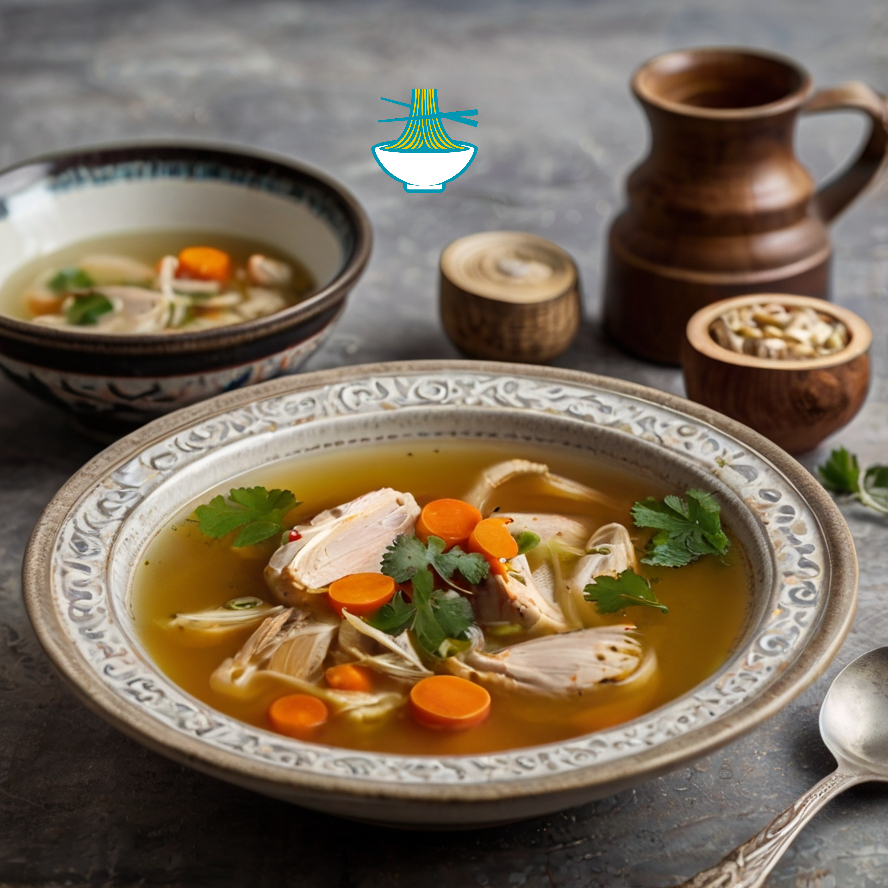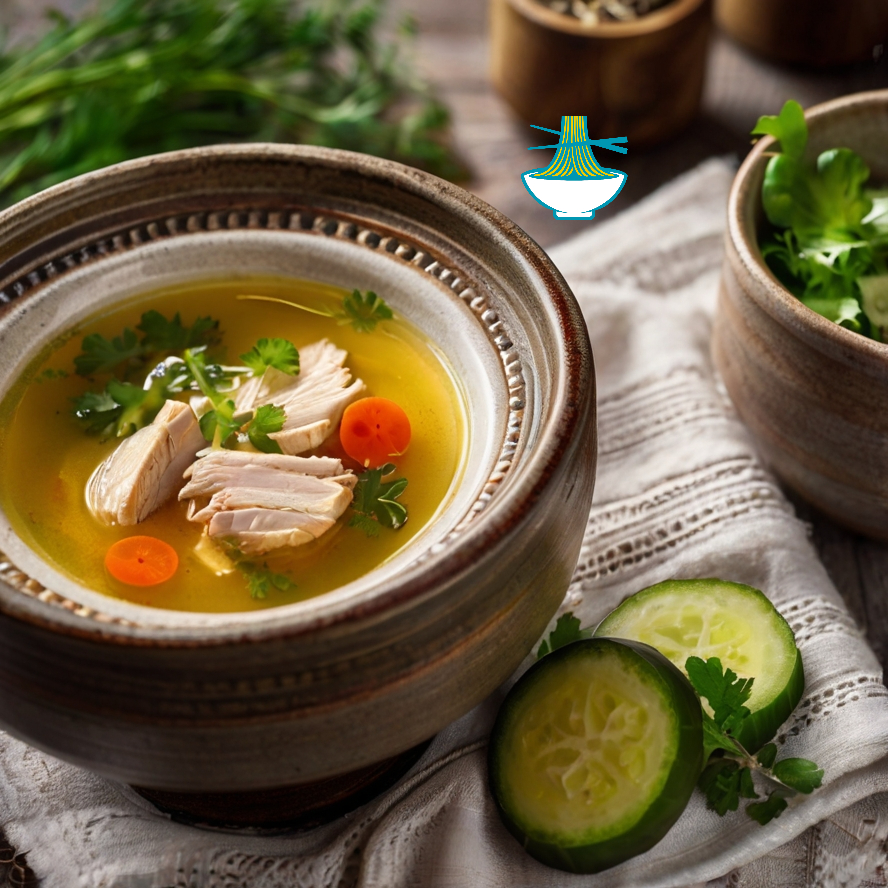Chicken soup is not only a comforting dish but also a scientifically supported remedy for enhancing immune function and supporting respiratory health. Research has shown that key components in chicken soup, such as amino acids, vitamins, minerals, and antioxidants, contribute to its therapeutic effects, particularly in viral infections like Human Metapneumovirus (HMPV). For example, cysteine, an amino acid released during cooking, helps break down mucus and reduces inflammation in the respiratory system (American Journal of Therapeutics, 2012). Vitamins A, C, and D strengthen immune responses and protect against oxidative stress (Journal of Clinical Medicine, 2020). Additionally, the high protein content aids tissue repair, and gelatin from the broth supports digestive health (Nutrition Reviews, 2014). Overall, chicken soup plays a vital role in alleviating inflammation, boosting immunity, and promoting recovery from respiratory illnesses.
Ingredients:
- 1 whole chicken (or 4 chicken breasts).
- 2 large carrots, sliced thinly.
- 2 celery stalks, sliced.
- 1 large onion, quartered.
- 3 garlic cloves, crushed.
- 1 teaspoon salt (or to taste).
- 1/2 teaspoon black pepper (or to taste).
- 3 liters water (approximately, depending on the pot size).
Preparation Method:
1. Prepare the Ingredients:
- Clean the chicken thoroughly (if using a whole chicken, remove any internal organs and excess fat).
- Peel and slice the carrots into thin rounds.
- Wash the celery and slice it.
- Peel the onion and cut it into quarters.
- Peel the garlic and crush it using a garlic press or by applying pressure with the side of a knife.
2. Cook the Chicken:
- In a large pot, place the whole chicken (or chicken breasts) and add enough water to cover the chicken completely.
- Place the pot over medium-high heat and bring the water to a boil.
- Once the water starts boiling, remove the foam that forms on the surface using a spoon or a skimmer.
3. Add the Vegetables:
- After removing the foam, add the carrots, celery, onion, and garlic to the pot.
- Add the salt and black pepper.
- Reduce the heat to low and let the mixture simmer for 1.5 to 2 hours, or until the chicken is fully cooked and the vegetables are tender.
4. Remove the Chicken:
- After the cooking time, carefully remove the chicken from the pot (if using a whole chicken, use a large spoon or tongs).
- If using a whole chicken, shred or cut the meat into small pieces once it cools down.
- If using chicken breasts, slice them into thin strips or small cubes as preferred.
5. Strain the Broth:
- Use a fine strainer to separate the broth from the vegetables and bones.
- You can return the broth to the pot or serve it as is.
6. Serve the Soup:
- Return the broth to the pot and bring it to a boil again for a few minutes to enhance the flavor.
- Add the shredded or sliced chicken back into the broth.
- Optionally, garnish with fresh herbs like parsley or cilantro for extra flavor.
7. Serving:
- Serve the chicken soup hot in bowls. You may also add toasted bread slices or a small amount of rice if desired.
Prevention of Respiratory Viruses and Infectious Diseases:
- Avoid Kissing Sick Individuals: Refrain from kissing those showing symptoms to reduce viral transmission.
- Frequent Hand Washing: Regular hand washing with soap and water, or using alcohol-based sanitizer, is effective in preventing virus spread, as recommended by the WHO and CDC.
- Wear a Mask if Sick: Wearing a mask helps prevent infection spread, especially when in contact with others (WHO, CDC).
- Avoid Sharing Personal Items: Do not share food, cups, or utensils to limit transmission.
- Avoid Touching Face: Refrain from touching eyes, nose, or mouth with unwashed hands, as these are common entry points for viruses.
- Drink Herbal Teas: Herbal drinks like green tea, aniseed, or caraway may alleviate symptoms and support immunity (NIH recommendations).
- Stay Home When Sick: Stay home to prevent spreading illness, especially respiratory infections (CDC, WHO).
- Disinfect High-Touch Surfaces: Clean frequently touched surfaces to minimize virus hotspots (CDC guidelines).
- Improve Ventilation: Open windows to allow airflow and reduce airborne virus concentration.
- PCR Testing: PCR testing is the most accurate for diagnosing certain viruses but not typically needed for mild cold or flu symptoms (CDC).
Following these preventive measures, as recommended by global health organizations like the WHO and CDC, can significantly reduce the risk of contracting and spreading infectious viruses.

Reliable Sources:
The statement is based on general preventive measures recommended by health organizations such as the World Health Organization (WHO) and Centers for Disease Control and Prevention (CDC). These guidelines are supported by various studies and public health reports. For example:
- WHO (2020) emphasizes hygiene, mask-wearing, and social distancing as key measures to prevent the spread of respiratory infections.
- CDC (2020) similarly highlights frequent hand washing, wearing masks, and avoiding close contact as essential for reducing transmission of respiratory viruses.
- https://www.cdc.gov/human-metapneumovirus/about/index.html
- https://www.cdc.gov/surveillance/nrevss/hmpv/index.html
- https://www.who.int/news-room/questions-and-answers/item/human-metapneumovirus-(hmpv)-infection
For immune support, National Institutes of Health (NIH) research underscores the role of nutrition and herbal remedies in boosting immune function, especially during cold and flu season.


Comments